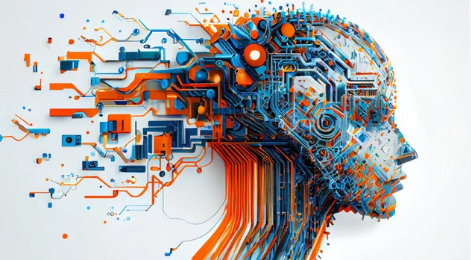Artificial Intelligence (AI) is no longer the future—it’s the present. In 2025, AI is everywhere, from virtual assistants and self-driving cars to advanced data analytics and hyper-personalized marketing. Understanding AI today is not just a matter of curiosity; it’s essential for professionals, businesses, and everyday users alike.
Whether you’re a tech-savvy entrepreneur or someone just trying to make sense of the rapid digital transformation, this guide will walk you through the fundamentals of AI, its real-world applications, the latest trends, and what to expect in the near future.
What Is Artificial Intelligence? A Clear and Simple Definition
Artificial Intelligence refers to the simulation of human intelligence in machines programmed to think, learn, and make decisions. These systems can analyze data, recognize patterns, and improve over time through machine learning (ML) and deep learning (DL).
In simpler terms, AI allows machines to mimic tasks that typically require human intelligence—like recognizing speech, translating languages, making recommendations, or even diagnosing medical conditions.
Core Components of AI You Should Know
Understanding AI starts with grasping its foundational elements. Here are the key components:
1. Machine Learning (ML)
Machine learning allows computers to learn from data without being explicitly programmed. The more data it receives, the smarter it gets. Applications include fraud detection, predictive analytics, and personalized content.
2. Deep Learning
A subset of machine learning, deep learning uses neural networks to simulate human decision-making. It’s essential for image recognition, natural language processing (NLP), and voice assistants like Siri or Alexa.
3. Natural Language Processing (NLP)
NLP enables machines to understand, interpret, and generate human language. This powers chatbots, translation apps, and AI writing tools.
4. Computer Vision
Computer vision allows machines to interpret and process visual data like images and videos. Think facial recognition, medical imaging, or autonomous driving.
AI in Everyday Life: Real-World Applications in 2025
AI is no longer confined to labs or tech companies. It’s integrated into daily life in ways you might not even notice:
Smart Devices and Virtual Assistants
AI powers voice assistants like Google Assistant and Apple’s Siri, helping users manage tasks, control smart homes, and get real-time answers.
Healthcare Innovations
AI assists doctors in diagnosing diseases through image analysis, predicting patient outcomes, and managing hospital operations more efficiently.
Finance and Banking
From automating trading strategies to detecting suspicious activities, AI has revolutionized how financial institutions manage risk and serve customers.
E-commerce and Marketing
AI personalizes shopping experiences, recommends products, optimizes ads, and predicts customer behavior.
Transportation and Mobility
Autonomous vehicles, route optimization, and real-time traffic updates rely heavily on AI algorithms.
Emerging AI Trends in 2025
AI technology is evolving rapidly. Here’s what’s shaping the AI landscape this year:
1. Generative AI
Tools like ChatGPT and DALL·E are leading the generative AI wave. These models can create text, images, music, and even videos—reshaping content creation and design.
2. AI and Cybersecurity
With increasing digital threats, AI is becoming a frontline defender—detecting breaches, analyzing vulnerabilities, and automating incident responses.
3. Edge AI
Instead of relying on the cloud, Edge AI processes data closer to the source (like your phone or IoT device), improving speed, privacy, and efficiency.
4. Explainable AI (XAI)
As AI becomes more powerful, so does the demand for transparency. XAI helps users understand how AI models make decisions, especially in sectors like healthcare and law.
5. AI in Education
Personalized learning platforms use AI to adapt to student needs, offering customized lesson plans, real-time feedback, and virtual tutoring.
The Benefits and Challenges of AI Adoption
While AI presents immense opportunities, it also brings unique challenges that businesses and individuals must navigate.
Benefits of AI
- Increased Efficiency: Automating repetitive tasks saves time and resources.
- Better Decision-Making: AI analyzes vast data sets to provide insights and forecasts.
- Enhanced User Experience: Personalized services keep users more engaged and satisfied.
Challenges of AI
- Bias and Fairness: AI can inherit biases from its training data, leading to unfair outcomes.
- Job Displacement: Automation may replace certain jobs, requiring workforce reskilling.
- Privacy Concerns: AI systems collect and analyze personal data, raising ethical questions.
- Dependence on Technology: Overreliance can reduce human oversight and critical thinking.
AI Ethics and Responsible Use
In 2025, ethical AI is not optional—it’s expected. Organizations must implement AI responsibly by:
- Ensuring data privacy and user consent.
- Auditing algorithms for bias.
- Making AI decision-making transparent.
- Involving diverse teams in AI development.
Governments are also enacting regulations to ensure AI is used in alignment with societal values and human rights.
Future of AI: What’s Coming Next?
As we look beyond 2025, AI will only become more deeply embedded in society. Some key predictions include:
- General AI: Moving from narrow AI (task-specific) to general AI capable of broader thinking.
- AI-Human Collaboration: AI will increasingly augment—not replace—human workers.
- Quantum AI: Combining quantum computing with AI could revolutionize problem-solving and speed.
- Fully Autonomous Systems: Expect major leaps in driverless cars, delivery drones, and smart cities.
How to Prepare for an AI-Driven World
Whether you’re an entrepreneur, employee, student, or simply curious, you can prepare for AI’s impact by:
- Learning AI Basics: Take online courses or certifications in AI and ML.
- Developing Digital Skills: Coding, data analysis, and prompt engineering are valuable skills.
- Staying Informed: Follow AI news, thought leaders, and emerging tools.
- Adapting with Agility: Embrace change and remain open to using AI in your profession or business.
Conclusion: Embracing AI as an Opportunity, Not a Threat
AI in 2025 is transformative, not terrifying. By understanding its fundamentals, staying informed on trends, and using it responsibly, we can harness the full potential of AI to enhance lives, boost business productivity, and solve global challenges.
Artificial Intelligence isn’t here to replace us—it’s here to work with us. And the more we understand it, the better prepared we’ll be to thrive in the intelligent era.
Also Read :
